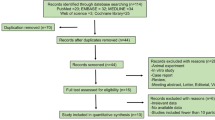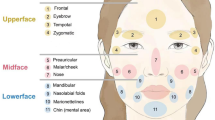Abstract
Background
Patients with depressed facial scars complain of their negative effects. However, the efficacy of optional treatment techniques is never completely adequate. This study aimed to assess the efficacy of nanofat injection in the improvement of depressed facial scars.
Methods
This retrospective study included patients who underwent depressed facial scar filling with nanofat between November 2017 and January 2020. The FACE-Q scale was sent to patients for feedback regarding satisfaction. Evaluations of the results were also performed by three plastic surgeons.
Results
Among the 52 included patients, 44 patients (29 women and 15 men) completed the questionnaire. Obvious and stable effects were usually acquired 3 months after surgery. Temporary erythema appeared at the injection site to varying degrees, lasting 2 to 3 weeks in 93% of the patients. No other serious postoperative complications were observed in the injection area. The FACE-Q outcomes showed that patients who completed injection therapy more than 1 year prior were significantly more satisfied with the decision to undergo this therapy than those who completed the treatment less than 1 year prior. Furthermore, according to the physicians’ evaluations, 91% of patients experienced improvement in scar appearance after treatment.
Conclusions
The low rate of injection-site complications and the safety of this procedure both support the current implementation of nanofat in the treatment of depressed facial scars. The results of the physicians’ evaluations and patient satisfaction surveys confirmed the stable effect of nanofat injection in the treatment of depressed facial scars.
Level of Evidence IV
This journal requires that authors assign a level of evidence to each article. For a full description of these Evidence-Based Medicine ratings, please refer to the Table of Contents or the online Instructions to Authors www.springer.com/00266






Similar content being viewed by others
References
Balaraman B, Geddes ER, Friedman PM (2015) Best reconstructive techniques: improving the final scar. Dermatol Surg 41(Suppl 10):S265-275
Inchingolo F, Tatullo M, Abenavoli FM, Marrelli M, Inchingolo AD, Corelli R, Inchingolo AM, Dipalma G (2011) Surgical treatment of depressed scar: a simple technique. Int J Med Sci 8:377–379
Coleman SR (2001) Structural fat grafts: the ideal filler? Clin Plast Surg 28:111–119
Schwabbauer ML (1975) Use of the latent image technique to develop and evaluate problem-solving skills. Am J Med Technol 41:457–462
Newberry CI, Thomas JR, Cerrati EW (2018) Facial scar improvement procedures. Facial Plast Surg 34:448–457
Roy D (2005) Ablative facial resurfacing. Dermatol Clin 23:549–559
Sobanko JF, Alster TS (2011) Laser treatment for improvement and minimization of facial scars. Facial Plast Surg Clin North Am 19:527–542
Coleman SR (1998) Structural fat grafting. Aesthet Surg J 18(386):388
Zuk PA, Zhu M, Mizuno H, Huang J, Futrell JW, Katz AJ, Benhaim P, Lorenz HP, Hedrick MH (2001) Multilineage cells from human adipose tissue: implications for cell-based therapies. Tissue Eng 7:211–228
Li L, Ngo HTT, Hwang E, Wei X, Liu Y, Liu J, Yi TH (2019) Conditioned medium from human adipose-derived mesenchymal stem cell culture prevents UVB-induced skin aging in human keratinocytes and dermal fibroblasts. Int J Mol Sci 21:49
Sarangal R, Yadav S, Sakral A, Dogra S (2015) Noncultured epidermal-melanocyte cell suspension and dermal-fat grafting for the reconstruction of an irregular, atrophic, and depigmented forehead scar: an innovative approach. J Cosmet Dermatol 14:332–335
La Rusca I, Schonauer F, Molea G (2009) Core fat graft transplantation for depressed scar. Plast Reconstr Surg 123:1394–1395
Cohen SR, Hewett S, Ross L, Delaunay F, Goodacre A, Ramos C, Leong T, Saad A (2017) Regenerative cells for facial surgery: biofilling and biocontouring. Aesthet Surg J 37:S16–S32
Tenna S, Cogliandro A, Barone M, Panasiti V, Tirindelli M, Nobile C, Persichetti P (2017) Comparative study using autologous fat grafts plus platelet-rich plasma with or without fractional CO2 laser resurfacing in treatment of acne scars: analysis of outcomes and satisfaction with FACE-Q. Aesthet Plast Surg 41:661–666
Tonnard P, Verpaele A, Peeters G, Hamdi M, Cornelissen M, Declercq H (2013) Nanofat grafting: basic research and clinical applications. Plast Reconstr Surg 132:1017–1026
Klassen AF, Cano SJ, Schwitzer JA, Scott AM, Pusic AL (2015) FACE-Q scales for health-related quality of life, early life impact, satisfaction with outcomes, and decision to have treatment: development and validation. Plast Reconstr Surg 135:375–386
Richards KN, Rashid RM (2011) Twenty-four-month persistence of hyaluronic acid filler for an atrophic scar. J Cosmet Dermatol 10:311–312
Lindenblatt N, van Hulle A, Verpaele AM, Tonnard PL (2015) The role of microfat grafting in facial contouring. Aesthet Surg J 35:763–771
Klinger M, Marazzi M, Vigo D, Torre M (2008) Fat injection for cases of severe burn outcomes: a new perspective of scar remodeling and reduction. Aesthet Plast Surg 32:465–469
Coban YK (2019) Application of the stromal vascular fraction of adipose tissue to a severe great toe defect resulting from third-degree electrical burn injury. J Burn Care Res 40:1009–1011
Maione L, Memeo A, Pedretti L, Verdoni F, Lisa A, Bandi V, Giannasi S, Vinci V, Mambretti A, Klinger M (2014) Autologous fat graft as treatment of post short stature surgical correction scars. Injury 45(Suppl 6):S126-132
Lo Furno D, Tamburino S, Mannino G, Gili E, Lombardo G, Tarico MS, Vancheri C, Giuffrida R, Perrotta RE (2017) Nanofat 2.0: experimental evidence for a fat grafting rich in mesenchymal stem cells. Physiol Res 66:663–671
Pallua N, Grasys J, Kim BS (2018) Enhancement of progenitor cells by two-step centrifugation of emulsified lipoaspirates. Plast Reconstr Surg 142:99–109
Gu Z, Li Y, Li H (2018) Use of condensed nanofat combined with fat grafts to treat atrophic scars. JAMA Facial Plast Surg 20:128–135
Tremolada C, Ricordi C, Caplan AI, Ventura C (2016) Mesenchymal stem cells in lipogems, a reverse story: from clinical practice to basic science. Methods Mol Biol 1416:109–122
Qiu L, Su Y, Zhang D, Song Y, Liu B, Yu Z, Guo S, Yi C (2016) Identification of the centrifuged lipoaspirate fractions suitable for postgrafting survival. Plast Reconstr Surg 137:67e–76e
Gentile P, Scioli MG, Bielli A, Orlandi A, Cervelli V (2017) Comparing different nanofat procedures on scars: role of the stromal vascular fraction and its clinical implications. Regen Med 12:939–952
Osinga R, Menzi NR, Tchang LA, Caviezel D, Kalbermatten DF, Martin I, Schaefer DJ, Scherberich A, Largo RD (2015) Effects of intersyringe processing on adipose tissue and its cellular components: implications in autologous fat grafting. Plast Reconstr Surg 135:1618–1628
Chadwick S, Heath R, Shah M (2012) Abnormal pigmentation within cutaneous scars: a complication of wound healing. Indian J Plast Surg 45:403–411
Ladak A, Tredget EE (2009) Pathophysiology and management of the burn scar. Clin Plast Surg 36:661–674
Imokawa G (2004) Autocrine and paracrine regulation of melanocytes in human skin and in pigmentary disorders. Pigment Cell Res 17:96–110
Mailey B, Saba S, Baker J, Tokin C, Hickey S, Wong R, Wallace AM, Cohen SR (2013) A comparison of cell-enriched fat transfer to conventional fat grafting after aesthetic procedures using a patient satisfaction survey. Ann Plast Surg 70:410–415
Kim JH, Jung M, Kim HS, Kim YM, Choi EH (2011) Adipose-derived stem cells as a new therapeutic modality for ageing skin. Exp Dermatol 20:383–387
Mahdavian Delavary B, van der Veer WM, van Egmond M, Niessen FB, Beelen RH (2011) Macrophages in skin injury and repair. Immunobiology 216:753–762
Yao Y, Dong Z, Liao Y, Zhang P, Ma J, Gao J, Lu F (2017) Adipose extracellular matrix/stromal vascular fraction gel: a novel adipose tissue-derived injectable for stem cell therapy. Plast Reconstr Surg 139:867–879
Kato H, Mineda K, Eto H, Doi K, Kuno S, Kinoshita K, Kanayama K, Yoshimura K (2014) Degeneration, regeneration, and cicatrization after fat grafting: dynamic total tissue remodeling during the first 3 months. Plast Reconstr Surg 133:303–313
Suh A, Pham A, Cress MJ, Pincelli T, TerKonda SP, Bruce AJ, Zubair AC, Wolfram J, Shapiro SA (2019) Adipose-derived cellular and cell-derived regenerative therapies in dermatology and aesthetic rejuvenation. Ageing Res Rev 54:100933
Coleman SR (2006) Structural fat grafting: more than a permanent filler. Plast Reconstr Surg 118:108S-120S
Swanson E (2011) Outcome analysis in 93 facial rejuvenation patients treated with a deep-plane face lift. Plast Reconstr Surg 127:823–834
Charles-de-Sa L, Gontijo-de-Amorim NF, Maeda Takiya C, Borojevic R, Benati D, Bernardi P, Sbarbati A, Rigotti G (2015) Antiaging treatment of the facial skin by fat graft and adipose-derived stem cells. Plast Reconstr Surg 135:999–1009
Eto H, Kato H, Suga H, Aoi N, Doi K, Kuno S, Yoshimura K (2012) The fate of adipocytes after nonvascularized fat grafting: evidence of early death and replacement of adipocytes. Plast Reconstr Surg 129:1081–1092
Hou A, Cohen B, Haimovic A, Elbuluk N (2017) Microneedling: a comprehensive review. Dermatol Surg 43:321–339
Funding
None.
Author information
Authors and Affiliations
Corresponding author
Ethics declarations
Conflict of interest
The authors declare that they have no conflicts of interest to disclose.
Ethical approval
All procedures performed in the study involving human participants were in accordance with the ethical standards of the institutional and/or national research committee and with the 1964 Helsinki Declaration and its later amendments or comparable ethical standards. This study was approved by the ethics committee of our hospital.
Informed consent
Informed consent was obtained from the patients to publish the images. Written informed consent was obtained from patients who participated in the follow-up study.
Additional information
Publisher's Note
Springer Nature remains neutral with regard to jurisdictional claims in published maps and institutional affiliations.
Rights and permissions
About this article
Cite this article
Huang, R., Jiao, H., Fan, J. et al. Nanofat Injection for the Treatment of Depressed Facial Scars. Aesth Plast Surg 45, 1762–1771 (2021). https://doi.org/10.1007/s00266-021-02178-7
Received:
Accepted:
Published:
Issue Date:
DOI: https://doi.org/10.1007/s00266-021-02178-7




